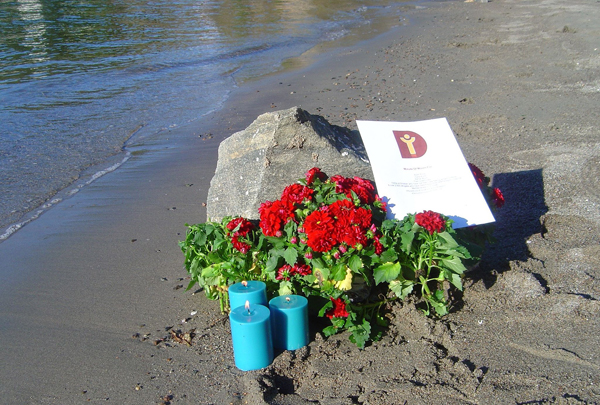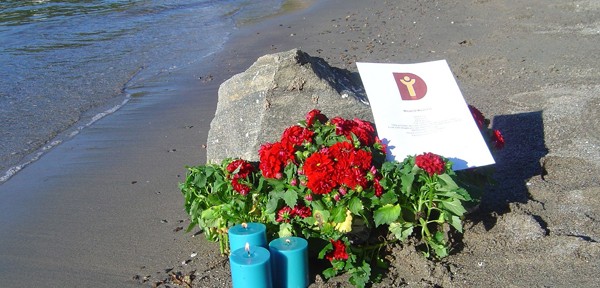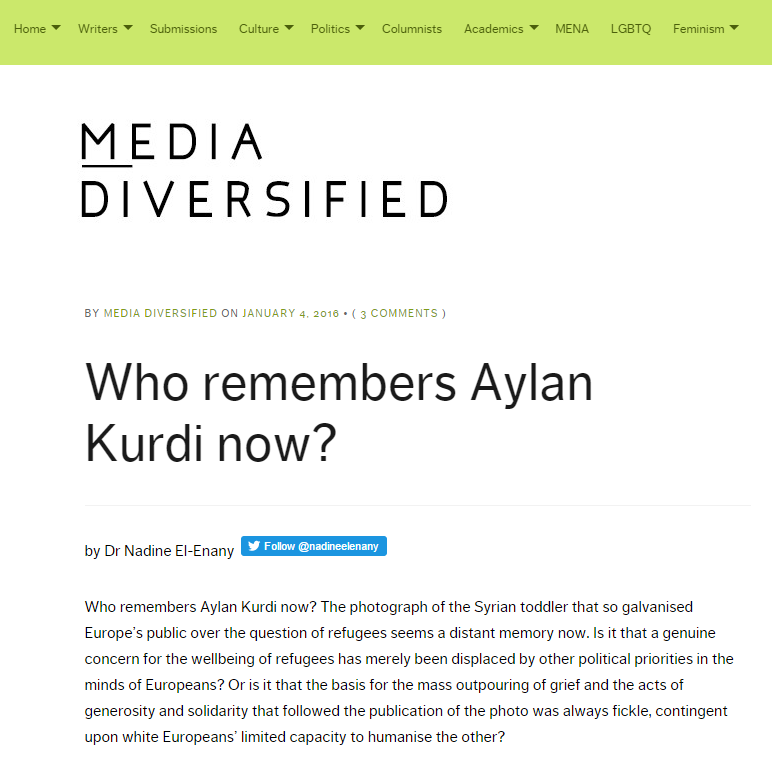This post was contributed by Dr Nadine El-Enany lecturer in Birkbeck’s School of Law. This first appeared on Media Diversified on 4 January 2016

Moments of Mourn held in memory of Aylan Kurdi and other refugees
Who remembers Aylan Kurdi now? The photograph of the Syrian toddler that so galvanised Europe’s public over the question of refugees seems a distant memory now. Is it that a genuine concern for the wellbeing of refugees has merely been displaced by other political priorities in the minds of Europeans? Or is it that the basis for the mass outpouring of grief and the acts of generosity and solidarity that followed the publication of the photo was always fickle, contingent upon white Europeans’ limited capacity to humanise the other?
What was it about the photo of Aylan Kurdi that so stirred Europe’s public over the question of refugees? Aylan Kurdi was by no means the first child to drown en route to Europe and since his death, more than 70 children have lost their lives off the Greek coast. Since 1993, more than 22, 394 people are known to have died attempting to enter Europe. The actual figure is likely to be much higher. The blood on the hands of Europe’s fortress-makers had long dried before Kurdi’s body washed up on a Turkish beach in September. How did it come about that white Europeans were able, all of a sudden, to humanise the body of a refugee, least of all, the body of a Muslim?
What did white Europeans see when they looked at the photo of Aylan Kurdi? They saw their own sons and nephews in the photo, aptly illustrated by the #CouldBeMyChild hashtag which was trending on Twitter following the discovery of Kurdi’s body. The image was of course particularly potent in depicting the tragic end of a life so young. But was there something else about this particular child that enabled his humanisation by white people, when so many others had died before?
Perhaps it was the innocence evoked by the body of a light-skinned child that enabled the temporary, fleeting awakening among white Europeans to a refugee movement that long-preceded the media spotlight on that photo. The news has moved on, but the situation persists and grows more desperate daily. According to the International Organisation for Migration, an estimated 700,000 people arrived at Europe’s borders between January and October 2015, compared with 280,000 for the entirety of 2014. Refugees fleeing persecution and war in Syria have been trying to reach Europe since 2012. The majority remain in neighbouring countries in the region, with only 10% of those fleeing Syria seeking protection in Europe. Many have perished along the way together with refugees from Afghanistan and Iraq.
Those white Europeans with a new penchant for carrying #RefugeesWelcome tote bags are unlikely to be amenable to the argument that this is the result of an awakening of their conscience made possible by the coincidentally fair hue of Aylan Kurdi’s skin. Yet, research has shown that the extent to which white people feel empathy and humanise others correlates with implicit racial biases, with negative stereotyping of those with darker skin coresponding to a lower level of empathy shown for them. Feelings of empathy are known to encourage cooperation and assistance between human-beings, while an absence of identification with the suffering of others can lead to violence and abuse, both characteristics of Europe’s militarised border regime.
What of the refugees who do not evoke in the mind of the white European an image of their own offspring? The images of black African bodies washed up on the shores of Europe’s mediterranean beaches last Spring did not prompt an equivalent outpouring of compassion and charitable action. What of the bearded male refugee? What of the woman in the hijab or burka? What of their dark-skinned children? These coded images of Muslims inhibit their humanisation. The Islamophobia that thrives in European societies today means that rather than compassion, they elicit feelings of apprehension and fear.
In the wake of the Paris attacks, the British newspaper, the Daily Mail, published a cartoon depicting racialised images of Muslims crossing Europe’s borders along with rats. Poland reneged on its refugee quota agreement following the attacks and more than half of all US state governors have refused to accept Syrian refugees. Meanwhile, Australia declared its policy was to focus its protection efforts on Christian Syrians.Each of these decisions is reproductive of Islamophobia in buying into the idea that Muslims are associated with terror by virtue of being Muslim.
Rather than acknowledge the racism endemic in European societies, many white Europeans prefer to see the dehumanisation of refugees as merely an expression of anti-migrant sentiment, or different values, or viewpoints in what is presented as a fair debate on migration. In what amounts to a dangerous apologia for racism, Slavoj Zizek has categorised the claims of anti-immigrant populists as being about the “protection of our way of life” and argued that the claim Europeans lack empathy for the suffering of others is “merely the obverse of…anti-immigrant brutality”. In a move demonstrative of his attachment of negative stereotypes to refugees, Zizek insists that it be “made clear” to them that they are to “respect the laws and social norms of European states” which entails “No tolerance of religious, sexist or ethnic violence”, as though sexist, racist and religious violence were not fundamental aspects of European life.
While Aylan Kurdi’s light skin colour may have allowed white Europeans to humanise him and partake in large-scale charity-giving, petition-signing and demonstrations, their children could not of course have met Aylan Kurdi’s end. It was, after all, the ancestors of the white Europeans tweeting selfies taken with their babies as they headed for their nearest #RefugeesWelcome march who colonised the lands from which these desperate people come. And it is white Europeans occupying positions of power and privilege today who continue to give orders for bombs to be dropped on their homes.
Absent from the #CouldBeMyChild hashtag was an understanding of the specificity of colonial histories and present imperial wars and the way in which these structurally determine positions of power and privilege as between white people and people of colour. Refugees are here, their bodies washing up on European beaches, because white Europeans were, and continue to be, there.
Find out more


